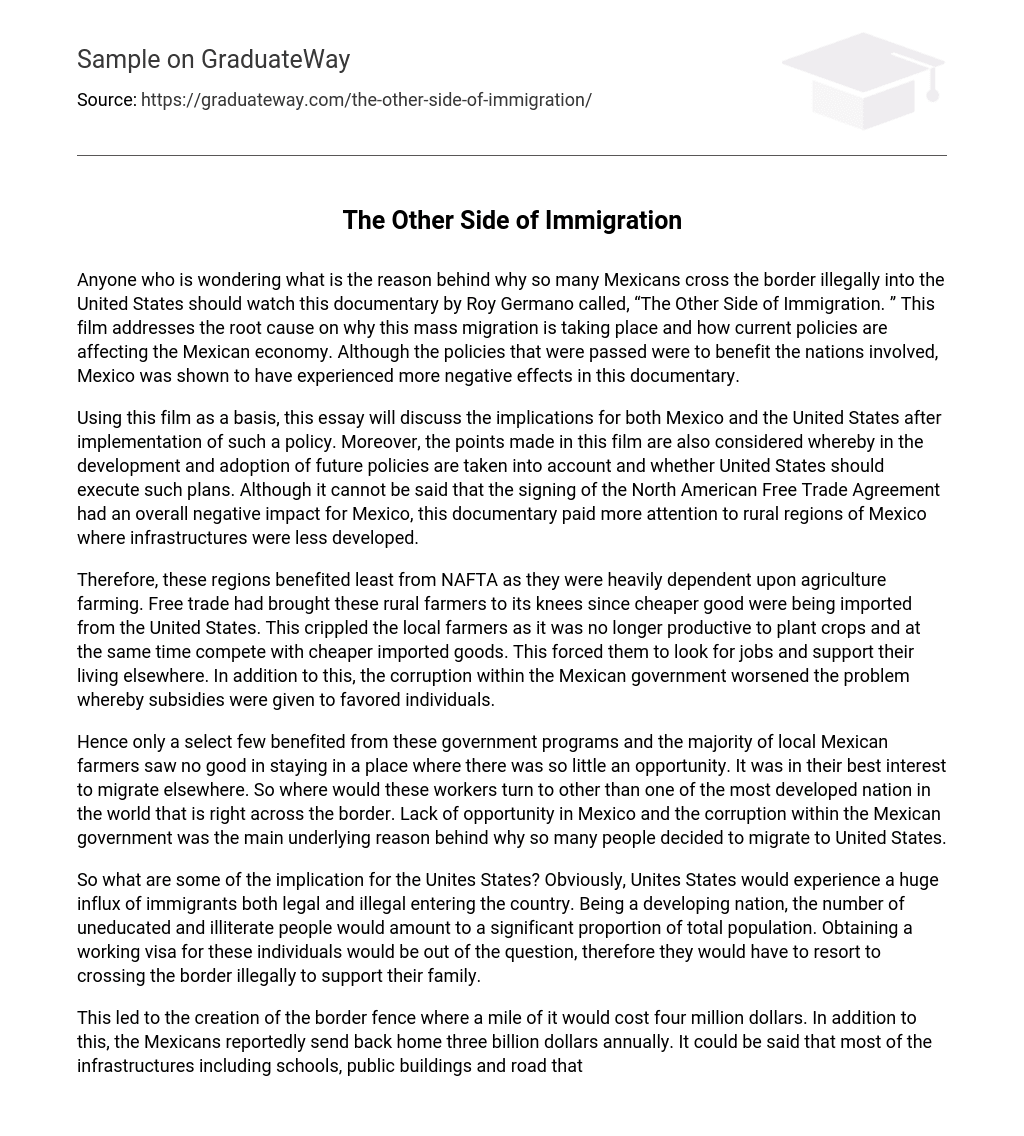“The Other Side of Immigration” is a documentary film by Roy Germano that delves into the reasons behind the illegal migration of numerous Mexicans across the US border. This film analyzes the underlying factors driving this extensive movement and examines how current policies affect Mexico’s economy. By aiming for mutual benefits, the documentary primarily focuses on highlighting negative outcomes for Mexico.
This essay will examine the effects of implementing a specific policy on both Mexico and the United States, using insights from the discussed film. Additionally, future policies will be influenced by the film’s arguments, and whether or not the United States should carry out such plans will be explored. Although it cannot be definitively stated that the signing of the North American Free Trade Agreement had solely negative consequences for Mexico, this documentary primarily highlights the underdeveloped rural areas of Mexico.
NAFTA had a detrimental impact on these agricultural-based regions that heavily relied on farming. The implementation of free trade resulted in considerable damage to the rural farmers who were unable to match the cheaper imported goods from the US. Consequently, their crop cultivation became unprofitable and compelled them to search for alternative employment opportunities. Moreover, this problem was worsened by corruption within the Mexican government, as it favored specific individuals through subsidies.
Because of limited opportunities and exclusive government programs, many local Mexican farmers opt to migrate elsewhere. The neighboring United States, being nearby and developed, became their favored choice for relocation. The primary factors driving this widespread migration included the scarcity of opportunities in Mexico and corruption within its government.
The United States would experience a notable rise in legal and illegal immigration. A considerable portion of the population would comprise uneducated and illiterate individuals because the country is still developing. Since it would be impractical for these people to obtain valid work visas, they would resort to illegal border crossings as a way to support their families.
The border fence, costing four million dollars per mile, was constructed as a result of Mexicans sending three billion dollars back to their home country annually. This financial contribution has contributed to the development of schools, public infrastructure, and highways in Mexico, thereby enhancing its economy. Nonetheless, this situation also increases the likelihood of more Mexicans attempting to cross over into the United States, which is a drawback for the nation.
The United States is dealing with increasing costs because of the increasing number of immigrants. This requires more extensive monitoring to stop undocumented workers from entering the country. However, this documentary offers a solution that is both simple and complex. It poses an interesting question – why spend so much taxpayer money on building a costly and outdated fence? Instead, why not think about investing in Mexico? A fence just creates a barrier for Mexicans to overcome and does not provide a lasting solution.
If the issue of illegal immigration is tackled directly, it has the potential to be permanently halted. The crucial element in preventing large-scale migration is making investments in Mexico, thereby generating employment prospects and providing individuals with incentives to remain. Nevertheless, implementing this solution may prove more challenging than initially perceived. Mexico possesses substantial developmental opportunities and its geological natural resources have yet to be fully explored; there exists a considerable likelihood that it holds a significant abundance of such resources.
Despite the peso devaluation discouraging investment in Mexico, the country still boasts a growing population of hardworking and smart individuals that appeals to potential investors (Ross, 67). Rather than focusing on constructing barriers, it would be more advantageous to invest in Mexico as this would generate opportunities and deter illegal immigration.
However, this issue is not as straightforward as merely constructing a factory. The investor must also weigh the potential benefits and profitability of the investment. The depreciation of the peso poses a significant obstacle for prospective investors. As for the implementation and advancement of future policies, it would be most prudent to maintain the current plan of restricting immigration into the United States. While this may only offer a temporary resolution to an escalating problem, it is presently the sole option available and the United States is left with no alternative.
Work Cited
The Other Side of Immigration, directed by Roy Germano and produced by Roy Germano Films in 2009, is a documentary film. In the Financial Analysts Journal, Carl D. Ross discusses the safety of investing in Mexico in his article titled “Is It Safe To Invest In Mexico?” which was published in 1959.





